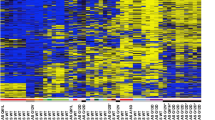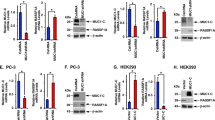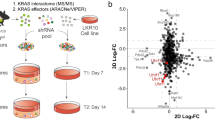Abstract
We recently demonstrated that RASSF1A, a new tumour-suppressor gene located at 3p21.3 is frequently inactivated by promoter region hypermethylation in a variety of human cancers including lung, breast, kidney and neuroblastoma. We have identified another member of the RASSF1 gene family by in silico sequence analysis using BLAST searches. NORE1 located at 1q32.1 exists in three isoforms (NORE1Aα, NORE1Aβ and NORE1B). Both NORE1A and NORE1B isoforms have separate CpG islands spanning their first exons. NORE1Aα Produces a 418 aa protein containing a Ras-association (RA) domain and a diacylglycerol (DAG) binding domain. NORE1Aβ produces a C-terminal truncation of the RA domain. NORE1B also contains the RA domain but not the DAG domain. NORE1 is the human homologue of the mouse Ras effector Nore1. No inactivating somatic mutations were found in lung tumour lines; however, NORE1A promoter region CpG island was hypermethylated in primary tumours and tumour cell lines. NORE1A promoter was methylated in 10/25 breast, 4/40 SCLC, 3/17 NSCLC, 1/6 colorectal and 3/9 kidney tumour cell lines, while NORE1B promoter was unmethylated in the same tumour cell lines. While 24% (6/25) of primary NSCLC underwent NORE1A methylation, methylation in SCLC was a rare event (0/22); (P=0.0234). NORE1A expression in tumour cell lines was reactivated after treatment with a demethylating agent. There was no correlation between NORE1A and RASSF1A methylation status in NSCLC. Our results demonstrate that NORE1A is inactivated in a subset of human cancers by CpG island promoter hypermethylation, and in lung cancer this hypermethylation may be histological type specific.
This is a preview of subscription content, access via your institution
Access options
Subscribe to this journal
Receive 50 print issues and online access
$259.00 per year
only $5.18 per issue
Buy this article
- Purchase on Springer Link
- Instant access to full article PDF
Prices may be subject to local taxes which are calculated during checkout






Similar content being viewed by others
References
Agathanggelou A, Honorio S, Macartney DP, Martinez A, Dallol A, Rader J, Fullwood P, Chauhan A, Walker R, Shaw JA, Hosoe S, Lerman MI, Minna JD, Maher ER and Latif F . (2001). Oncogene, 20, 1509–1518.
Astuti D, Agathanggelou A, Honorio S, Dallol A, Martinsson T, Kogner P, Cummins C, Neumann HP, Voutilainen R, Dahia P, Eng C, Maher ER and Latif F . (2001). Oncogene, 20, 7573–7577.
Baylin S and Bestor TH . (2002). Cancer Cell, 1, 299–305.
Burbee DG, Forgacs E, Zochbauer-Muller S, Shivakumar L, Fong K, Gao B, Randle D, Kondo M, Virmani A, Bader S, Sekido Y, Latif F, Milchgrub S, Toyooka S, Gazdar AF, Lerman MI, Zabarovsky E, White M and Minna JD . (2001). J. Natl. Cancer Inst., 93, 691–699.
Byun DS, Lee MG, Chae KS, Ryu BG and Chi SG . (2001). Cancer Res., 61, 7034–7038.
Campbell SL, Khosravi-Far R, Rossman KL, Clark GJ and Der CJ . (1998). Oncogene, 17, 1395–1413.
Dammann R, Li C, Yoon JH, Chin PL, Bates S and Pfeifer GP . (2000). Nat. Genet., 25, 315–319.
Dammann R, Takahashi T and Pfeifer GP . (2001). Oncogene, 20, 3563–3567.
Downward J . (2001). Nature, 411, 759–762.
Dreijerink K, Braga E, Kuzmin I, Geil L, Duh FM, Angeloni D, Zbar B, Lerman MI, Stanbridge EJ, Minna JD, Protopopov A, Li J, Kashuba V, Klein G and Zabarovsky ER . (2001). Proc. Natl. Acad. Sci. USA, 98, 7504–7509.
Jones PA and Baylin SB . (2002). Nat. Rev. Genet., 3, 415–428.
Khokhlatchev A, Rabizadeh S, Xavier R, Nedcoidek M, Chen T, Zhang XF, Seed B and Avruch J . (2002). Curr. Biol., 12, 253–265.
Lee MG, Kim HY, Byun DS, Lee SJ, Lee CH, Kim JI, Chang SG and Chi SG . (2001). Cancer Res., 61, 6688–6692.
Lerman MI and Minna JD . (2000). Cancer Res., 60, 6116–6133.
Lo KW, Kwong J, Hui AB, Chan SY, To KF, Chan AS, Chow LS, Teo PM, Johnson PJ and Huang DP . (2001). Cancer Res., 61, 3877–3881.
Maruyama R, Toyooka S, Toyooka KO, Virmani AK, Zochabauer-Muller S, Farinas AJ, Minna JD, McConnell J, Frenkel EP and Gazdar AF . (2002). Clin. Cancer Res., 8, 514–519.
Morrissey C, Martinez A, Zatyka M, Agathanggelou A, Honorio S, Astuti D, Morgan NV, Moch H, Richards FM, Kishida T, Yao M, Schraml P, Latif F and Maher ER . (2001). Cancer Res., 61, 7277–7281.
Ortiz-Vega S, Khokhlatchev A, Nedwidek M, Zhang XF, Dammann R, Pfeifer GP and Avruch J . (2002). Oncogene, 21, 1381–1390.
Ponting CP and Benjamin DR . (1996). Trends Biochem. Sci., 21, 422–425.
Tommasi S, Dammann R, Jin SG, Zhang XF, Avruch J and Pfeifer GP . (2002). Oncogene, 21, 2713–2720.
Vavvas D, Li X, Avruch J, Zhang XF . (1998). J. Biol. Chem., 273, 5439–5442.
Vos MD, Ellis CA, Bell A, Birrer MJ and Clark GJ . (2000). J. Biol. Chem., 275, 35669–35672.
Acknowledgements
This work is supported in part by the Cancer Research UK. JDM supported by SPORE P50CA70907. The colorectal tumour cell lines were provided by Ian P M Tomlinson.
Author information
Authors and Affiliations
Corresponding author
Rights and permissions
About this article
Cite this article
Hesson, L., Dallol, A., Minna, J. et al. NORE1A, a homologue of RASSF1A tumour suppressor gene is inactivated in human cancers. Oncogene 22, 947–954 (2003). https://doi.org/10.1038/sj.onc.1206191
Received:
Revised:
Accepted:
Published:
Issue Date:
DOI: https://doi.org/10.1038/sj.onc.1206191
Keywords
This article is cited by
-
NORE1A directs apoptotic switch of TNF signaling through reciprocal modulation of ITCH-mediated destruction of TNFRI and BAX
Oncogene (2020)
-
In silico analysis predicting effects of deleterious SNPs of human RASSF5 gene on its structure and functions
Scientific Reports (2020)
-
Tumor suppressor C-RASSF proteins
Cellular and Molecular Life Sciences (2018)
-
RASSF1 tumor suppressor gene in pancreatic ductal adenocarcinoma: correlation of expression, chromosomal status and epigenetic changes
BMC Cancer (2016)
-
NORE1A induction by membrane-bound CD40L (mCD40L) contributes to CD40L-induced cell death and G1 growth arrest in p21-mediated mechanism
Cell Death & Disease (2016)



